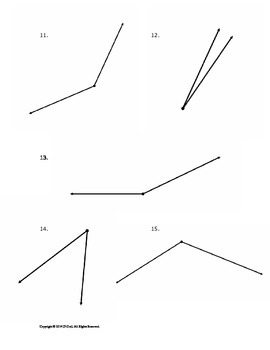
Unless you’re currently studying in college, there’s probably little reason why you’d need a digital protractor out of work. It can come in many different styles and configurations, but the main idea is the same- the device measures how much the protractor has been adjusted, and calculates the exact angle based on the adjustment. What is a digital protractor?Ī digital protractor is a special type of protractor designed to measure an angle as accurately as possible through the use of electronics.

#ANGLES PROTRACTOR HOW TO#
Here’s how to find the right digital protractor for your next project.
#ANGLES PROTRACTOR PROFESSIONAL#
It’s simple and easy to use, which is why it’s commonly found in many workshops and professional studios. Through the use of circuitry, one can easily get the precise measurement of angles without having to account for human error at all. The quality and convenience of digital devices have slowly driven the latter to obsolescence.ĭigital protractors are one such example of tools that have become far more reliable through modern technology. Whether it’s rulers, compasses, and even barometers, digital devices are simply more accurate and reliable than their analog counterparts. In this day and age, there’s a digital version for pretty much any analog tool you can think of. Check out our list of the best digital protactors in 2022. Some low cost units have plastic legs, rather than metal ones, which could become more and more inaccurate over time. While most units are more or less the same on this, low cost units might not be as accurate. For some types of work, especially furniture making, shorter legs on the protractor might be advantageous.īesides size, the other major consideration when looking at a digital protractor is accuracy.

However, long protractors can be limited by the spaces they will fit in. These digital protractors are a much more accurate means of measuring angles for carpentry, cabinetmaking, furniture making and general woodworking.ĭigital protractors come in different lengths and generally speaking, it’s easier to get an accurate measurement when using a longer one. This saves the step of measuring the angle of the protractor, while also increasing its accuracy. While these digital protractors have everything simpler models do, they add a digital readout that measures and displays the angle formed by the two legs. Once the angle is measured, the digital protractor can be placed against the blade and table of a saw, allowing the angle to be set exactly.

The protractor can also be used to set up tools for cutting operations. Once removed from the location, the angle between the two legs is measured or transferred directly to the piece to be cut. To use them, the two legs are placed against the two surfaces making the angle and the wingnut tightened to lock them in place. There is no integral means of determining the angle and in that sense, these tools are more a gauge than a measuring device.Īt its simplest level, a carpenter’s protractor consists of nothing more than those two legs, with a bolt and wingnut to hold them together. That limits the protractor quite a bit, as it needs to be able to fit inside or outside the angle. Protractors used for carpentry work are used for measuring angles but these angles are on three dimensional objects. About the only limitation is it’s possible to see through the protractor to the lines on the paper. As such, it really isn’t limited to size or configuration. A geometry protractor is used for measuring an angle drawn on a piece of paper.

When we’re talking about digital protractors, we’re not discussing the kind you used to use in school for geometry.


 0 kommentar(er)
0 kommentar(er)
